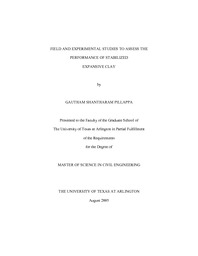
ATTENTION: The works hosted here are being migrated to a new repository that will consolidate resources, improve discoverability, and better show UTA's research impact on the global community. We will update authors as the migration progresses. Please see MavMatrix for more information.
Show simple item record
| dc.contributor.author | Pillappa, Gautham S | en_US |
| dc.date.accessioned | 2007-08-23T01:56:16Z | |
| dc.date.available | 2007-08-23T01:56:16Z | |
| dc.date.issued | 2007-08-23T01:56:16Z | |
| dc.date.submitted | August 2005 | en_US |
| dc.identifier.other | DISS-1018 | en_US |
| dc.identifier.uri | http://hdl.handle.net/10106/199 | |
| dc.description.abstract | A vast majority of the expansive soils are montmorillonite-rich clays, over consolidated clays and shales. The swell and shrinkage movements of expansive soil cause considerable damage to structures such as buildings and pavements. This damage can be attributed to moisture fluctuations caused by seasonal variations. Volumetric changes typically appear in the form of cracks which will lead to the softening and vertical heaving in subsoils. Both softening and vertical expansion induce damage to overlying structures. Certain soils rich with sulfates exhibit swell and heaving even after treatment with stabilizers.
The present research project was conducted at the University of Texas at Arlington as part of a research project for the City of Arlington mainly to develop alternate stabilization methods for the sulfate rich soils of South Arlington. Based on a comprehensive literature review of expansive soil treatment methods and separate laboratory studies, the following four novel stabilizers were recommended for field treatment: Sulfate Resistant Cement (Type V), Low Calcium Class F Fly Ash with Cement, Ground Granulated Blast Furnace Slag and Lime mixed with Polypropylene Fibers. The laboratory tests included unconfined compressive strength test, resilient modulus test, linear shrinkage, Atterberg limits and plasticity index tests.
Subsequently, the stabilizers were used to treat subsoil with high percentage of sulfates. Field investigations and performance monitoring of this pavement built on five different subgrades, including lime, were carried out. Field monitoring instrumentation with strain gauges and pressure cells was performed to address both pressure transfer mechanism and material compression under traffic loads. Data monitoring was conducted for a period of seven months. Elevation surveys were also conducted to evaluate the swell movements of the treated pavement sections. X-ray diffraction analyses were also conducted on treated subgrade samples to address the formation of Ettringite mineral. Based on all these evaluations, the four stabilization methods were ranked against the control lime section. Overall, cement treatment method followed by the
other three alternate methods provided stable and uniform pavement support to the
traffic. | en_US |
| dc.description.sponsorship | Puppala, Anand | en_US |
| dc.language.iso | EN | en_US |
| dc.publisher | Civil & Environmental Engineering | en_US |
| dc.title | Field And Experimental Studies To Assess The Performance of Stabilized Expansive Clay | en_US |
| dc.type | M.S. | en_US |
| dc.contributor.committeeChair | Puppala, Anand | en_US |
| dc.degree.department | Civil & Environmental Engineering | en_US |
| dc.degree.discipline | Civil & Environmental Engineering | en_US |
| dc.degree.grantor | University of Texas at Arlington | en_US |
| dc.degree.level | masters | en_US |
| dc.degree.name | M.S. | en_US |
| dc.identifier.externalLink | https://www.uta.edu/ra/real/editprofile.php?onlyview=1&pid=969 | |
| dc.identifier.externalLinkDescription | Link to Research Profiles | |
Files in this item
- Name:
- umi-uta-1018.pdf
- Size:
- 4.691Mb
- Format:
- PDF
This item appears in the following Collection(s)
Show simple item record


